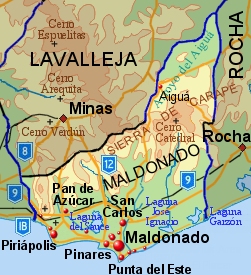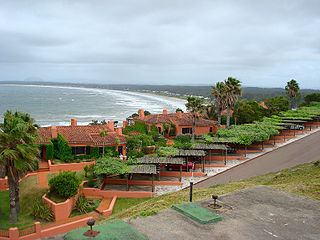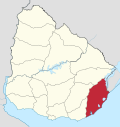Rocha is a department in the east of Uruguay. Its capital is the city of Rocha. It borders Maldonado Department to its west, Lavalleja Department to its northwest, Treinta y Tres Department to its north, while to its northeast Laguna Merín forms part of its border with Brazil and at the south end of the lake it also borders the southernmost end of Brazil, with the city of Chuy "shared" between both countries, the border passing through its main commercial avenue.

The Maldonado Department, with an area of 4,793 km2 (1,851 sq mi) and 164,300 inhabitants (2011), is located to the southeast of Uruguay. Its capital is Maldonado.

Laguna del Sauce is a subtropical shallow lake and the largest water body in the Maldonado Department of Uruguay. It is located 15 kilometres (9.3 mi) west of Punta del Este. The lake is the only freshwater ecosystem in the country classified for drinking water as its principal use.

Rocha is the capital city of the Rocha Department in Uruguay.

Punta del Diablo is a village and seaside locality in Uruguay, Rocha Department, 298 kilometres (185 mi) east from the capital Montevideo. According to the 2011 census, its permanent population consisted of 823 inhabitants, mostly fishermen and artisans, while during high tourism season, the population swells to approximately 25,000, mostly with Argentinians, Brazilians and Europeans on holiday. As with the country it is located in, the primary language spoken in Punta del Diablo is Spanish. In 2008 it was named by the magazine "Lonely Planet" as one of the top 20 places to visit and invest.

Route 10 is a national route of Uruguay. In 1983, it was assigned the name Juan Díaz de Solís, honouring the Spanish navigator.

Punta Ballena is a small peninsula (punta) and a resort (balneario), as well as an important tourist attraction on the coast of Río de la Plata in the Maldonado Department of southeastern Uruguay. It comprises an approximately 12 kilometres (7.5 mi) long stripe of beaches and landforms and extends on both sides of Route 10.

Aguas Dulces is a resort in the Rocha Department of southeastern Uruguay.

Santa Teresa National Park is a seaside forested area in Rocha Department which is an important national park of Uruguay. It is operated by the National Army of Uruguay. It is located in the Atlantic coast southeast of Route 9 at the northeast side of Laguna Negra and just north of Punta del Diablo.
The National System of Protected Natural Areas of Uruguay is an instrument of policy implementation and national environmental action plans for Uruguay.

Laguna de Rocha is an important body of water located in Rocha Department, Uruguay. The lagoon and its surroundings were declared a protected area in 1977.

Laguna José Ignacio is a body of water located between Maldonado Department and Rocha Department, Uruguay.
Laguna de Castillos is an important water body in the Rocha Department of Uruguay. It is located 15 kilometres (9.3 mi) south of Castillos and 50 kilometres (31 mi) northeast of Rocha. It is considered an important wildlife refuge and bird sanctuary.

The Municipality of Maldonado is one of the eight municipalities of Maldonado Department, Uruguay. It was created by Law N° 18653 of 15 March 2010.

Laguna José Ignacio is a body of water located in Maldonado Department, Uruguay.
Laguna Negra is the Spanish translation for "black lagoon". It may refer to:
Naturism in Uruguay is practiced at least since the 1960s, firstly by foreigners coming to Uruguay and later by Uruguayan naturists. It is being practiced on the two officially designated naturist beaches : Chihuahua beach in Maldonado that is the most known, and the other is La Sirena Beach in Rocha.

The Uruguayan Institute of Meteorology or INUMET for short, is the weather agency that provides meteorological and climatological services to Uruguay. It is also the aeronautical meteorological authority of the country in application of the Convention on International Civil Aviation (ICAO).















